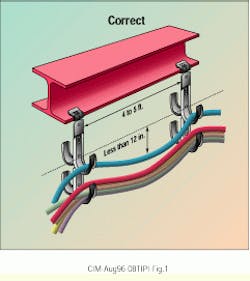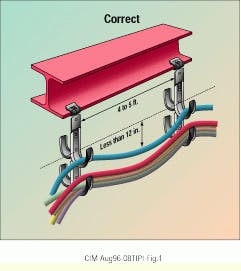Use wide-base "J" hooks to support Category 5 cable
Scott Laughlin, Erico Inc.
Problem
When Category 5 cable is pulled, it requires special handling and must be supported more than the less-sensitive voice-grade cable used in traditional cable pulls. Specifically, the bend radius of Category 5 cable can be exceeded and stress points created when using narrow-base fasteners such as cable ties and bridle rings to hang and support cable bundles. Overbending, twisting and stressing Category 5 cable can damage it, leading to network failure when data transmission speeds approach the full 100-MHz potential of the cable.
Solution
Horizontal cabling trays can be used to solve the problem, but they are expensive and time-consuming to install. A more practical solution is the use of "J"-hook fasteners specially designed for Category 5 installations. These fasteners feature a wide base with smooth, rounded corners to eliminate the potential for snags during installation, while preventing the development of stress points where the cable bundle is supported. Commercially available "J" hooks and accessories enable easy and fast installation in a number of environments--on beams, "C" or "Z" purlin, acoustical trees, drop wires, decks, and ceilings. (Note that Category 5 cable should never be laid on top of a suspended ceiling.)
Procedure
1) Attach the appropriate "J"-hook fastener--whether for wall, stud, beam, flange or drop-wire mounting--to the supporting structure. Space fasteners to fall every 4 to 5 feet.
2) Lay the cable in the "J" of the fasteners. Make sure that the cable sag between fasteners is no more than 12 inches at midspan. (Actual cable sag will depend on the number of cables in each bundle and the weight of the cable.) If the sag is greater than 12 inches, add additional fasteners.
3) If the "J" hook can accommodate a cable tie, use the prepunched holes in the fastener to install the tie. This prevents the cable from lifting. Be sure that the cable tie does not put pressure on the cables because this can cause distortion of the cable geometry.
4) Check your installation. The overall appearance of installed cable should be neat.
During installation, keep cable-pulling tension constant and ensure that it stays below the EIA/TIA-568A specification of 25 pounds maximum for Category 5 cable.
Scott Laughlin is a product design and development specialist in the Fastening Products Group of Erico Inc. in Solon, OH.
Using a bridle ring to support Category 5 cable creates unacceptable bending and stress on the cables, especially those at the bottom of a bundle.
"J"-hook fasteners manufactured for Category 5 installations provide a broad base for cable support, reducing stress and bending. The fasteners can support several cables at a time.


